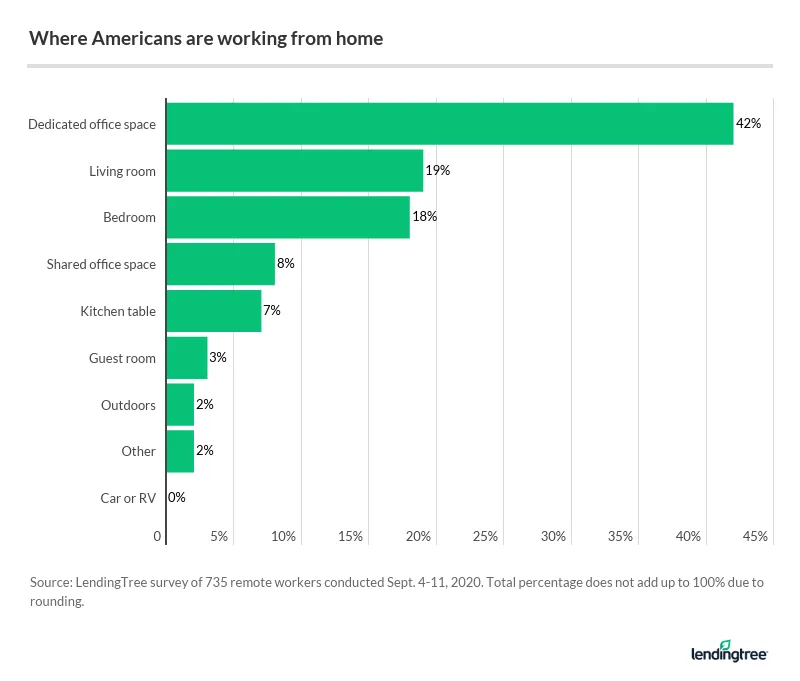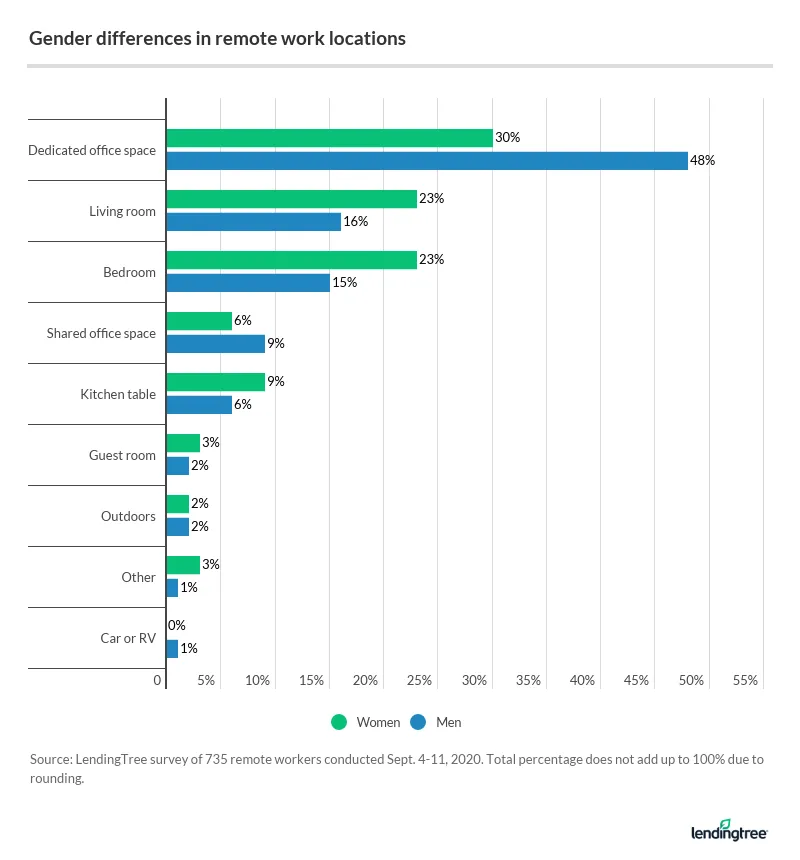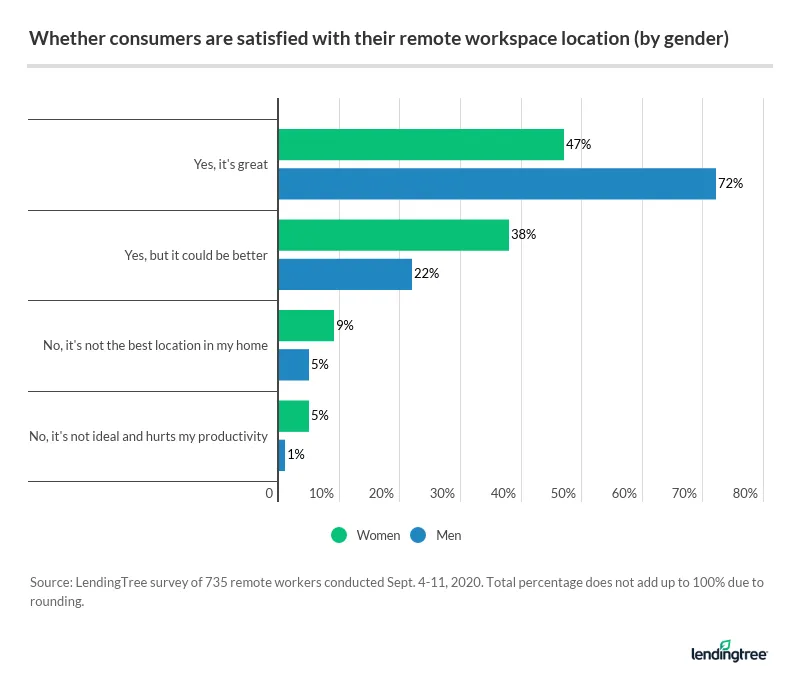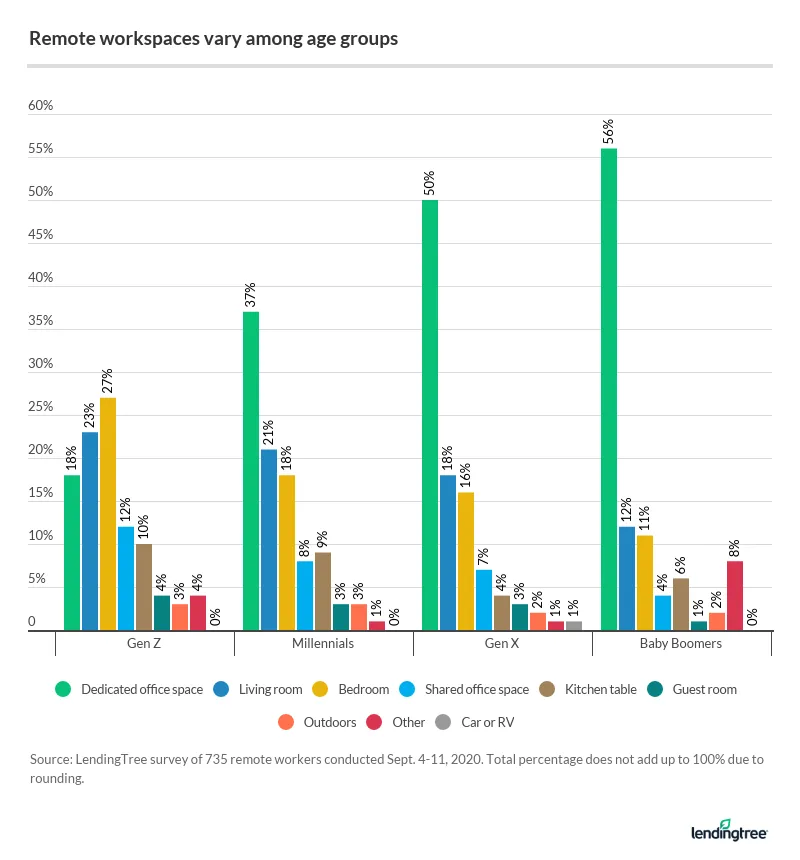LendingTree Survey Reveals Nearly Half of Americans Are Working From Home, With Men Likelier to Have a Dedicated Office
The coronavirus pandemic has upended the way Americans work, with more and more employees working from home if they have the privilege to do so.
However, a new LendingTree survey finds that not all work-from-home spaces are created equal. For starters, men are more likely to have access to a dedicated home office space than women, and more millennials and Gen Zers are working from their bedroom or living room than baby boomers and Gen Xers.
The survey of more than 2,000 respondents, including 700-plus remote workers, provides a glimpse at how Americans currently feel about working remotely.
Key findings
- Overall, 47% of respondents are currently working from home. Members of Generation X, men, Northeasterners and those with an annual income of at least $100,000 are among those most likely to work remotely.
- Men working remotely are 60% more likely than women to be using their own dedicated office space. Men are also more likely to be completely satisfied with their remote work space than women (72% versus 47%, respectively).
- Nearly half (48%) of millennials are either working from their bedroom, living room or kitchen table. On the other hand, older Americans are more likely to work from their own dedicated office space.
- Homeowners are primarily working from a dedicated office space, while a majority of renters turned to their living rooms. Homeowners are also more satisfied with their remote work location than renters (75% versus 44%, respectively).
- White workers are significantly more likely to be working out of their own dedicated office space than any other racial demographic. More than half (52%) of white remote workers are using their own home office, compared with a quarter (27%) of Black workers, 23% of Latino workers and 23% of Asian workers.
Nearly half of Americans are currently working from home
Our survey found that 47% of Americans are working remotely from home these days. The top three in-home work spaces are:
- Dedicated office space (42%)
- Living room (19%)
- Bedroom (18%)

More than half (53%) of all homeowners are primarily working from their own dedicated office space, while renters primarily turned to their living rooms (26%). Another 24% of renters have a dedicated home office, while 22% work remotely from their bedroom.
More than a quarter (27%) of survey respondents say they’re thinking about moving within the next year to a new house or apartment in their local area. Of those in this group, 27% are thinking of moving because they’re looking for different features, such as a bigger kitchen or office space. This finding underscores the growing importance homebuyers are placing on purchasing a property that includes space for a home office.
“The demand for home office space — and space in general — is driving up sales of larger homes faster than smaller homes,” said Tendayi Kapfidze, LendingTree’s chief economist. “Price increases accompany the increase in demand and this erodes some of the benefits of low mortgage rates. To maximize buying power, it’s even more important for home shoppers to compare mortgage offers from a variety of lenders.”
Northeasterners are most likely to work from home. Here’s the regional breakdown:
- Northeast: 60%
- West: 44%
- South: 42%
- Midwest: 39%
Men are more likely to have a dedicated office space
When comparing men to women, our survey found that men working from home are significantly more likely — 60% more likely — to have a dedicated office space in their home than women. Nearly half (48%) of men have a home office, while just under a third (30%) of women report the same.

Men are two times more likely than women to say they’re currently working from home, which may help explain the higher likelihood of men having a home office to themselves.
Our survey also found that women are more likely to work from their bedroom and living room than men. Additionally, 7 in 10 men report being satisfied with their in-home work space; just 47% of women say the same.
About 5% of women say their work space isn’t ideal and impacts productivity, compared with just 1% of men.

Older generations are more likely to work from a home office
Baby boomers are the generation most likely, at 56%, to have their own dedicated office space, followed by Generation X (50%). However, 3 out of 4 Gen Xers work from home, which is more than any other generation. Here’s the breakdown:
- Gen X: 76%
- Millennials: 53%
- Gen Z: 51%
- Baby boomers: 21%
- Silent generation: 8%
About 1in 5 millennials say they most often work from their living room, while more than a quarter (27%) of Gen Zers work from their bedroom.

The longer you participate in the workforce, the more income you tend to earn. In line with this trend, our survey results also found that the more you earn, the more likely you are to work from home. About 3 in 4 (74%) of Americans earning at least $100,000 annually are working from home, compared with 1 in 5 (22%) of those who earn less than $25,000 each year.
Methodology
LendingTree commissioned Qualtrics, an experience management firm, to conduct an online survey of more than 2,000 Americans — including 735 remote workers — with the sample base proportioned to represent the overall population. The survey was fielded Sept. 4-11, 2020.
We defined generations by using the following age ranges:
- Generation Z: 18-23
- Millennials: 24-39
- Generation X: 40-54
- Baby boomers: 55-74
- Silent generation: 75 and older
View mortgage loan offers from up to 5 lenders in minutes
Read more
57% of Workers Considering Looking for a New Job, With Only 51% Earning More Than a Year Ago Updated September 18, 2023 Inflation has risen sharply over the last three years — however, many Americans’ salaries haven’t,…Read more
Rate of People Working From Home Shifts by Up to 65% in Past Year Depending on State — Here’s Where It’s Down (and Up) Updated November 28, 2022 The latest LendingTree study reveals that the percentage of people who’ve worked from home has…Read more

